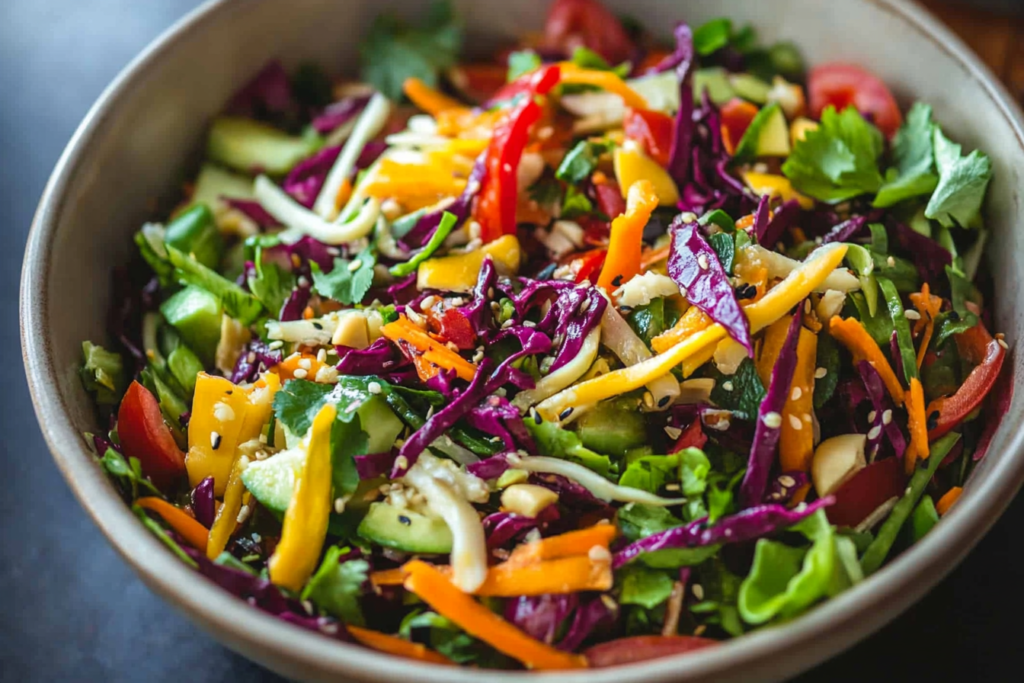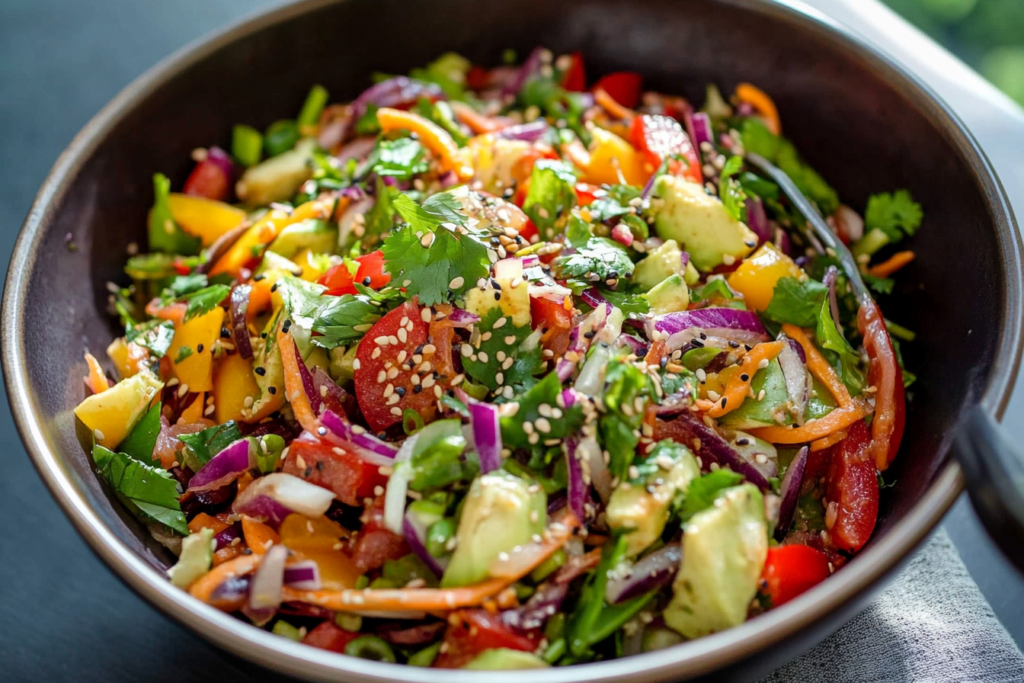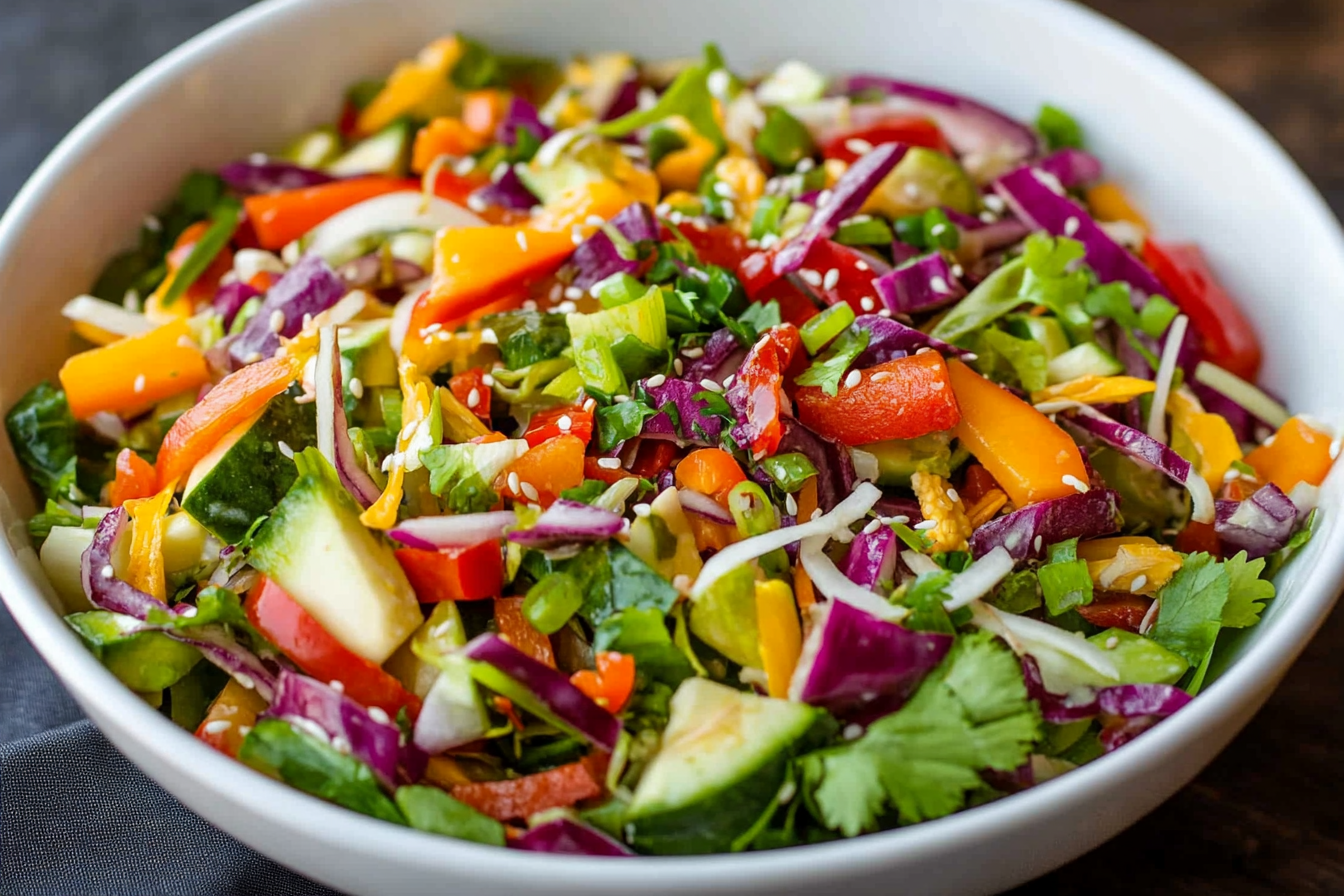A Personal Taste of Asia – Why This Salad Speaks to the Soul
There’s something undeniably comforting about food that balances flavor, freshness, and nourishment. If you’ve ever found yourself craving a dish that’s light enough to feel clean but flavorful enough to be satisfying, this is where the journey begins. An Asian salad recipe can offer all of that in one colorful, vibrant bowl.
Perhaps you remember tasting something similar on a trip or at a small restaurant tucked away in the city—crispy greens, tangy dressing, a hint of sesame, and the unmistakable zip of ginger. That kind of dish stays with you. The good news is, you don’t need to travel far or search for a restaurant menu to enjoy this flavor profile. You can recreate it right in your kitchen, with ingredients that are easy to find and methods that don’t require hours in front of the stove.
Whether you’re trying to eat cleaner, prepare your meals for the week, or just try something new, this Asian salad recipe gives you more than just a meal. It gives you a sensory experience rooted in balance, wellness, and bold flavors.
Table of Contents
Why You’ll Love This Asian Salad Recipe
When you make this salad, you’re not just putting together vegetables. You’re crafting a meal that checks all the boxes: quick, healthy, budget-friendly, and brimming with flavor. Here’s why you’ll keep coming back to it:
- It’s packed with crunchy vegetables, rich in fiber and nutrients
- The dressing is bold, tangy, and perfectly balanced with a touch of sweetness
- It’s incredibly versatile—you can add protein, skip ingredients, or scale up for meal prep
- The texture is layered and satisfying, from soft herbs to crispy toppings
- It can be adapted to fit gluten-free, vegan, or low-carb diets
This is more than a salad. It’s a full plate that can be customized to your needs and preferences.
The Ingredients That Bring It to Life
One of the keys to creating a great Asian salad recipe is using ingredients that complement one another in texture and taste. Below, you’ll find a complete breakdown of everything you need to build the perfect base and whip up a dressing that transforms it from simple to stunning.
Salad Base
| Ingredient | Quantity | Notes |
|---|---|---|
| Napa cabbage | 3 cups, shredded | Light, crisp texture |
| Red cabbage | 1 cup, shredded | Adds color and crunch |
| Carrots | 1 cup, julienned | Natural sweetness |
| Red bell pepper | 1, thinly sliced | Mildly sweet, vibrant |
| Cucumber | 1, sliced thin | Hydrating and crisp |
| Green onions | 2, chopped | Subtle sharpness |
| Cilantro | ¼ cup, chopped | Refreshing, bright finish |
| Slivered almonds | ¼ cup, toasted | Adds nutty depth |
| Crispy wonton strips | ½ cup | Optional, adds crunch |
You can prepare most of these ingredients in advance and store them separately until you’re ready to assemble.
Dressing
| Ingredient | Quantity | Notes |
|---|---|---|
| Soy sauce | 3 tbsp | Choose low-sodium if needed |
| Rice vinegar | 2 tbsp | Provides tangy balance |
| Sesame oil | 2 tsp | Toasted for rich aroma |
| Honey or maple syrup | 1 tbsp | Adds natural sweetness |
| Fresh ginger | 1 tsp, grated | Sharp, warm flavor |
| Garlic | 1 clove, minced | Aromatic and savory |
| Lime juice | 1 tbsp | Brightens the overall taste |
| Red pepper flakes | ¼ tsp | Optional, for light heat |
What sets this dressing apart is its ability to bring together savory, sweet, and acidic components in perfect harmony. You don’t need a blender or special equipment—just a small bowl and a whisk.
Step-by-Step Instructions for Making the Perfect Asian Salad

Creating this dish doesn’t require complicated techniques. With a few easy steps, you’ll have a fresh, flavorful salad that looks as good as it tastes.
1. Prepare the Vegetables
Start by washing and shredding the cabbages. If you’re using a mandoline or food processor, it can make the process faster, but a sharp knife works just as well. Julienne the carrots for that perfect thin, crunchy texture. Slice the bell pepper and cucumber into strips, and chop the green onions and cilantro.
Keep all components chilled if you’re prepping ahead of time. This helps preserve both the crispness and color of the vegetables.
2. Mix the Dressing
In a bowl or small jar, combine the soy sauce, rice vinegar, sesame oil, honey or maple syrup, lime juice, ginger, and garlic. Shake or whisk until emulsified. If you prefer a slightly sweeter profile, adjust the sweetener to taste. Want more heat? Add a pinch more red pepper flakes.
3. Combine and Toss
Place all your vegetables in a large salad bowl. Pour the dressing evenly across the top. Use tongs or salad servers to gently toss the ingredients until every piece is lightly coated in dressing. Allow the salad to sit for 5–10 minutes. This gives the flavors time to develop and blend.
4. Add Final Toppings
Just before serving, sprinkle toasted slivered almonds and crispy wonton strips over the top. These ingredients provide a satisfying crunch and round out the texture of the dish.
You’ve now created a salad that’s visually striking, nutritionally powerful, and deeply satisfying.
Creative Variations and Customizations for Your Asian Salad Recipe
What makes this Asian salad recipe truly timeless is its flexibility. You’re not bound to a strict set of ingredients. Instead, think of this as a template you can build on, depending on what’s in your fridge, your dietary needs, or even the season. Here are a few smart ways to customize it:
Protein Add-Ins
- Grilled Chicken: A lean protein that absorbs the flavors of the dressing beautifully
- Seared Tofu: Perfect for plant-based diets; press and pan-sear for texture
- Shrimp: Light, quick-cooking, and adds a seafood twist
- Edamame: Shelled edamame offers protein and a bright green pop
Veggie Swaps and Additions
- Swap red cabbage with green cabbage if that’s what you have
- Add mango slices for a burst of sweetness
- Throw in some sugar snap peas for more crunch
- Try radishes for an earthy, peppery bite
Diet-Friendly Tips
- Low-carb: Skip the wonton strips and carrots; use extra cucumbers and greens
- Gluten-free: Use tamari or coconut aminos instead of soy sauce
- Vegan: Use maple syrup instead of honey for the dressing
You’re not just making a salad—you’re crafting a bowl of color, texture, and flavor that fits your lifestyle.
Make-Ahead Tips and Storage Suggestions

You might be wondering if this salad holds up after the first day—and the answer is yes, with a few adjustments.
For Meal Prep:
- Store the dressing separately until you’re ready to eat. This keeps the veggies crisp
- Pre-chop your vegetables and store them in airtight containers lined with paper towels
- If using proteins like tofu or chicken, cook and store them separately, adding before serving
Storage Guidelines:
- Dressed salad lasts about 1 day in the refrigerator before getting soggy
- Undressed salad stays fresh for up to 3 days when stored correctly
- Dressing keeps for up to 1 week in the fridge in a sealed container
This approach allows you to enjoy your Asian salad across multiple meals without sacrificing quality.
Nutritional Benefits Backed by Science
Every bite of this salad isn’t just flavorful—it’s packed with nutrients your body will appreciate.
- Cabbage and carrots are high in antioxidants and fiber, supporting digestive health
- Sesame oil contains heart-healthy fats and antioxidants like sesamol
- Ginger and garlic offer anti-inflammatory benefits and support immunity
- Lime juice and vinegar assist in digestion and provide a refreshing acidity
According to a 2021 study in Nutrients, fiber-rich, plant-based meals like this one are associated with better metabolic health and lower inflammation markers. You’re not just feeding your cravings; you’re nourishing your system from the inside out.
Inspiring Recipes to Explore Next
If you’re loving this Asian salad recipe, you might want to dive deeper into similar dishes that deliver bold flavors in a bowl. One great example is the Asian Chopped Salad featured by Natasha’s Kitchen. It builds on similar flavor foundations but introduces elements like crunchy ramen noodles and a different take on the dressing, giving you a new way to enjoy these ingredients.
For something a little more Mediterranean-Asian fusion, consider exploring this Fregula Pasta Salad. While fregula isn’t traditionally used in Asian cuisine, it blends well with tangy dressings and crisp vegetables, offering an unexpected but delightful twist. You’ll find that both salads share the philosophy of letting fresh ingredients shine, while giving you room to make it your own.
Trying variations like these helps expand your salad game while staying true to your health and flavor goals.
Frequently Asked Questions (FAQ) – Asian Salad Recipe
What makes this Asian salad recipe different from others?
This version is focused on a perfect balance of flavor, texture, and nutrition. It uses traditional ingredients like sesame oil, ginger, and rice vinegar but leaves room for customization. Unlike store-bought kits, you control the sodium, sweetness, and overall profile.
Can I make the Asian salad dressing in advance?
Absolutely. You can mix the dressing up to a week ahead of time and store it in the refrigerator. Be sure to shake or stir it before using, as natural separation will occur.
Is this salad suitable for vegans?
Yes—with a quick switch. Use maple syrup instead of honey in the dressing and skip any animal-based proteins. Tofu, tempeh, or edamame make excellent vegan-friendly add-ins.
What protein works best with this Asian salad recipe?
Grilled chicken, shrimp, seared tofu, or sliced steak all work beautifully. Choose based on your dietary preferences. You can also add shelled edamame or roasted chickpeas for a plant-based protein option.
How long does the salad stay fresh?
Undressed, this salad can stay crisp for up to 3 days in an airtight container. Once dressed, aim to eat it within 24 hours to retain optimal texture and flavor.
Can I use pre-cut vegetables?
Yes, but for the best flavor and texture, fresh-cut ingredients are preferred. If using bagged coleslaw mix as a shortcut, pair it with fresh herbs and a homemade dressing to elevate the taste.
Is this Asian salad gluten-free?
With a small tweak, yes. Swap regular soy sauce for gluten-free tamari or coconut aminos. Always double-check packaged items like wonton strips if you’re adding them.
Final Thoughts: Why This Asian Salad Recipe Belongs in Your Weekly Rotation
By now, you’ve seen how this Asian salad recipe isn’t just another bowl of greens—it’s a meal that hits every note. It’s fresh, flavorful, flexible, and full of ingredients that nourish your body while satisfying your cravings. Whether you’re looking for a quick lunch, a vibrant side dish, or a make-ahead meal, this salad can rise to the occasion.
What makes this recipe stand out is how it gives you control. You choose your vegetables, your proteins, your level of spice, and your own twist on the dressing. That’s what turns a simple salad into something you look forward to—again and again.
If you’ve been stuck in a food rut or just want to add more color and nutrients to your plate, this is the kind of dish that delivers on both taste and well-being. And once you’ve made it your own, you may never go back to store-bought salad kits again.
Quick-Glance Recap Table
| Component | Options |
|---|---|
| Base Vegetables | Cabbage, carrots, bell peppers, cucumbers |
| Protein Add-ins | Grilled chicken, tofu, shrimp, edamame |
| Crunch Elements | Wonton strips, peanuts, sesame seeds |
| Dressing Elements | Soy sauce, sesame oil, lime juice, ginger, garlic, honey or maple syrup |
| Custom Additions | Mango, snap peas, radishes, chili flakes |
| Storage Tips | Store dressing separately; consume dressed salad within 24 hours |
Tips for Serving and Pairing
- Serve chilled with grilled meats for a balanced dinner
- Pair with jasmine rice or rice noodles for a fuller meal
- Add a cup of miso soup or green tea for a light lunch combo
- Bring it to potlucks or BBQs—it’s a guaranteed crowd-pleaser
Call to Action: Make It Yours
Now it’s your turn. Grab your favorite vegetables, mix up a bold dressing, and create your own perfect bowl. Whether you’re prepping lunches or feeding a group, this Asian salad recipe can be adapted to fit your needs.
If you try it, share your version or variations—you might inspire someone else to make their first homemade Asian salad too. Ready to give it a try?
Let the chopping begin.

